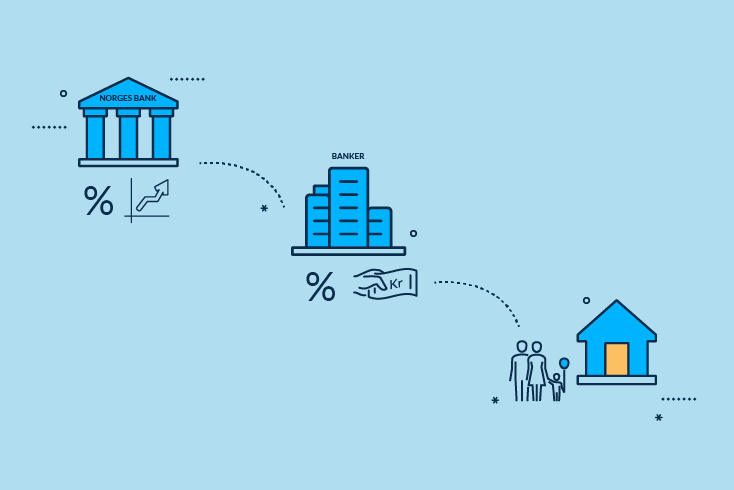How does the policy rate influence other interest rates?

Who receives the policy rate?
Norges Bank is Norway’s central bank – the bankers’ bank. Banks settle payments to each other by transferring deposits between their accounts in Norges Bank.
Once the Monetary Policy and Financial Stability Committee determines the policy rate, this means in practice that the Committee sets the banks’ deposit rates in Norges Bank up to a certain amount, ie a quota.
If a bank’s deposits exceed the bank’s quota, it receives a lower rate on its deposits in excess of the quota. This rate is called the reserve rate.
If a bank does not have deposits but needs to borrow from Norges Bank to settle its payments, the bank has to pay a lending rate. This rate is called the overnight lending rate or the D-loan rate.
How do banks distribute deposits among themselves?
Throughout the day, banks’ customers (households and firms) transfer money to each other in millions of different transactions. The final settlement from one bank to another always takes place through Norges Bank. When banks receive customer deposits, banks’ deposits are increased in Norges Bank. When banks transfer customer deposits, banks’ deposits are reduced in Norges Bank.
At the end of the day, banks with more deposits than their quota receive a lower rate on their deposits in excess of the quota, whereas banks with deposits below the quota need to borrow from Norges Bank at the overnight lending rate.
In both cases, it is more profitable for these banks to redistribute deposits among themselves so that their deposits only earn the policy rate. Thus, banks with excess deposits lend to banks with room in their quota at a rate equal to the policy rate.
This is how the policy rate also influences loans between banks. Interest rates on interbank loans then in turn influence credit and deposit rates offered by banks to their customers, such as rates on residential mortgages and savings accounts.
How does Norges Bank control the size of banks’ deposits?
Norges Bank decides the deposit quota size for each individual bank. In addition, Norges Bank controls the level of banks’ total deposits in Norges Bank at all times so that the total is lower than banks’ total quotas. It will thus always be possible and profitable for banks to redistribute deposits among themselves at an interest rate close to the policy rate.
At the same time, banks’ total deposits in Norges Banks can vary substantially from day to day, primarily because large payments are made to and from the government’s account at Norges Bank. When the government makes payments to households and firms, such as social security payments, these payments are from Norges Bank and through the banking system, resulting in increased total bank deposits in Norges Bank. When households and firms make tax payments to the government’s account, banks’ deposits in Norges Bank are reduced.
To keep banks’ total deposits in line with the quotas, Norges Bank must therefore sometimes supply and sometimes withdraw reserves to/from the banking system. This is carried out through what are called market operations, in which Norges Bank provides banks with access to its deposit and lending facilities through auctions. These facilities are called “F-deposits” and “F-loans,” respectively. Read more about the liquidity management system here
Short summary
- The policy rate applies to banks’ deposits in Norges Bank – up to a certain quota.
- The quota-based system makes it profitable for banks to redistribute deposits among themselves at an interest rate equal to the policy rate.
- By controlling the level of total deposits, Norges Bank ensures that the policy rate influences the interest rates offered by banks to each other and their customers, such as rates on residential mortgages and savings accounts.